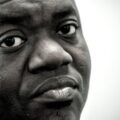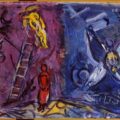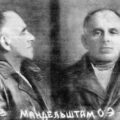“Because he is me”: on Jill Lepore’s history of Joe Gould and Joseph Mitchell

Joe Gould’s Teeth will be many things to many readers, but it advances most forcefully a clear-eyed critique of History and Literature (the name, incidentally, of the academic program Lepore has chaired at Harvard) by distinguishing them carefully from something quite other than either, here called “reporting.” Jill Lepore, award-winning Harvard historian and staff writer at The New Yorker, attempts to establish a proof-text of her own research methods and achieve a writing style answerable to them. The project arose, appropriately, from the classroom. On the syllabus of her course, “What Is Biography?” Lepore decided to include not biographies per se but “books that I love and that say something cautionary and wise about the error of believing you can ever really know another person.”
Reporting, Lepore writes, “begins with listening; history begins with reading. The past is what’s written down. It is very quiet; only people who can write make any sound at all.” Neither Joe Gould, the purported inventor of oral history, nor Joe Mitchell, Joe Gould’s own oral historian, amounted to much as historians. In fact, Lepore claims, they led each other hand in hand down the path to the garden of Literature, whose enjoyment they ultimately denied each other, and us, thanks to their failure to make a full report of the facts.
Lepore makes no such error. Instead, she folds inside the book a report on the report. Her endnotes occupy close to a third of her book’s pages. The first sentence self-consciously occasions the first endnote. Her work can be called pedantic in the best possible way—in the purest interest of showing her work. She tells a good story about telling a good story without slipping into the infinite regress this task threatens to entail. She manages this feat by…simply telling a good story, which in this case means pairing documentation and reflection in order to demystify, for our benefit, the magical process whereby truth emerges, however briefly, from the bath of speculation.
The late New Yorker reporter Joseph Mitchell was born in 1908 on his family’s tobacco farm outside the small town of Fairmont, in the flat swamp-country of southeastern North Carolina. He celebrated in his many articles men and women lived to the highest degree imaginable in and by their day-jobs, which they prided themselves in regarding as not simply a means of “getting on” but as a way of life, a habit of mind, of body and, in every instance, of soul as well. “Stones rot the same as bones rot, and nothing endures but the spirit,” one of them tells Mitchell. The spirit of Ecclesiastes broods over many of Mitchell’s stories. Few run their course before arriving at a “graveside moment” in which the afterlife steps into the limelight.
In the Author’s Note that he prefixed to the 1992 omnibus edition of his collected contributions to the New Yorker, Mitchell mentions the surprise with which he notices that a kind of humor, which he can only call graveyard humor, turns up in the pages. On some of them it is what the story is all about, he says. In others it lurks around in the background or in between the lines. “It turns up often in the conversations that I chose to quote. I was pleased to discover this because graveyard humor is an exemplification of the way I look at the world,” he writes. “It typifies my cast of mind.”
This “strong undercurrent” of humor, he explains, is “the kind of humor that the old Dutch masters caught in those prints that show a miser locked in his room counting his money and Death is standing just outside the door.” It is “Old Testament humor,” or “Gogolian humor,” citing Breughel’s painting of the halt leading the blind, and then recalling his Aunt Annie, who, when he was a child, would walk with him and his mother through the family burying ground in Robeson County pausing at a plot to tell him about the man or woman down below: “This man buried here,” she would say, “was a cousin of ours, and he was so mean I don’t know how his family stood him. “And this man here” she would continue, moving along a few steps, “was so good I don’t know how his family stood him.” And then she would become more specific, Mitchell writes. “Some of the things she told us were horrifying and some were horrifyingly funny.”
Lepore examines a horrifying, perhaps horrifyingly funny, relationship that Mitchell formed with one of the dozens of New Yorkers he immortalized in his “paper” (as he insisted on calling The New Yorker magazine), elaborating the details of Mitchell’s convoluted history with the titular subject.
Joe Gould was homeless, elderly, a Harvard graduate, a haunter of downtown hangouts. Lepore draws first of all from the pair of articles Mitchell devoted to the tale of Gould’s life’s work, the so-called “Oral History of Our Time,” a book of recorded hearsay the ever-growing length of which Gould once estimated to be “nine million two hundred and fifty-five thousand words long, or about a dozen times as long as the Bible.” In discussing this two-part profile in the context of her own extensive archival research, Lepore begins to explore the relationship between truth and fact, fiction and non-fiction, an author and the material.
“Joe Gould is a blithe and emaciated little man who has been a notable in the cafeterias, diners, barrooms, and dumps of Greenwich Village for a quarter of a century. He sometimes brags rather wryly that he is the last of the bohemians. ‘All the others fell by the wayside,’ he says. ‘Some are in the grave, some are in the loony bin, and some are in the advertising business.’” This is the opening of “Professor Sea Gull,” Mitchell’s first treatment of his subject, from 1942. Notice how Mitchell reaches right for the essence of the character. The tense is present, the adjectives are absolute. Gould is and always will be “blithe” and “emaciated,” as if these attributes were not accidental but encoded in his genome and destined to follow him to the grave.
Predicate nominalization of this kind attaches to every person Mitchell describes, and the whiff of implausibility it imparts accounts for much of the gentle humor of his writing. In another piece a shad-fisherman is fixed as “one of those short, hearty, robust men who hold themselves erect and swagger a little and are more imposing than many taller, larger men.” His face is “strong-jawed and prominent-nosed and bushy-eyebrowed and friendly and reasonable and sagacious and elusively piratical.” In another article, “The Rats on the Waterfront,” a different species of rodent gets the same rap: “Its nose is blunt, and its ears are small and alert, and its eyes are sharp and shiny and joyless and resentful and accusing.”
Most of us wouldn’t limn the features of our own mothers in such bold strokes. Where does Mitchell get the nerve? He seems to have been the widest-eyed transplant to the Big Apple ever to put pen to paper. “Until I came to New York City,” he writes in the introduction to his first book, My Ears Are Bent, a sampler of his newspaper stories that became a bestseller in 1938, “I had never lived in a town with a population of more than 2,699, and I was alternately delighted and frightened out of my wits by what I saw.” He was by diverse accounts also a virtuoso noticer as well as a listener of some genius, with a knack for nailing down details with what he called “wild exactitude.”
“Professor Sea Gull” is a checkerboard of gloss and quotation. The first-person pronoun never rears its pointy head, but Mitchell’s “cast of mind,” held discreetly in suspension, renders the tissue of the whole transparent, leaving behind no marks, like one of Freud’s magic-slates. This kind of “magical” observation is bred of detachment, but it does not issue from an ironical attitude. It effects instead an ironization of the material. Mitchell’s irony, like his melancholy and morbidity, is not subjective, applied from without to the object under investigation, but formal: its pressure arises internally by means of reflection from within the object at hand, whose self-defensive carapace it begins to decompose, disclosing the immediate factual existence of the object as a mystery, hinting at the object’s unique relationship to a hidden truth.
Mitchell’s technique enlists the highly particularized generalization in service of delicately controlled equivocation. He observes nothing singular, nothing determinate, fixing in view only the self-knowledge already nascent in the object. His bivocal ventriloquism is masterly: “Although Gould strives to give the impression that he is a philosophical loafer, he has done an immense amount of work during his career as a bohemian.” Or: “Inevitably, at every party Gould goes to, he gets up on…a table and delivers some lectures.” In its not-knowing, in its attending, Mitchell’s observation just knows better, being practically identical with the object. There is a coincidence of the objective and subjective side in his knowledge of the facts.
It quickly becomes clear that Mitchell never conducted interviews; he only ever had conversations. The New Yorker granted him the luxury of time that the cultivation of sufficient intimacy demanded. “Excellent quality, low productivity,” is how Harold Ross summed Mitchell up, giving him a ten-year deadline extension on his profile of a Brooklyn gypsy king. The questions Mitchell asked Gould, if indeed he asked any, are devilishly difficult to deduce from the product on the published page. In an interview with a journalism professor conducted shortly before he died, Mitchell explains: “You’re trying to report, at the beginning without knowing it, the unconscious as well as the consciousness of a man or woman. One thing you have to do, if you’re going to write this sort of thing is realize that people have buried their pain and have transformed experience enough to allow them to endure it and bear it. If you stay with them long enough, you let them reveal the past to themselves, thereby revealing it to you. Then they will dare to bring out the truth of something even if it makes them look bad.”
Apart from letting him set his own pace, the editors of The New Yorker indulged Mitchell’s taste for the eccentric and overlooked: street-preachers, a bearded lady, a gifted child, a self-commissioned commodore are drawn into his magic circle. “The only people I do not care to listen to are society women, industrial leaders, distinguished authors, ministers, explorers, moving picture actors (except W.C. Fields), and any actress under the age of thirty-five,” Mitchell proclaimed at the age of thirty. “I believe the most interesting human beings, so far as talk is concerned, are anthropologists, farmers, prostitutes, psychiatrists, and an occasional bartender. The best talk is artless, the talk of people trying to reassure or comfort themselves, women in the sun, grouped around baby carriages, talking about their weeks in the hospital or the way meat has gone up, or men in saloons, talking to combat the loneliness everyone feels.”
Mitchell’s second account of Gould clocks in at five times the length of the first, at one hundred pages. The novella-length article, “Joe Gould’s Secret,” was published in two parts in back-to-back issues of The New Yorker in 1964—almost twenty years in the making. This second installment was the last piece of Mitchell’s writing to appear in the magazine during his lifetime.
Gould took the inspiration for his “Oral History”—a term that some actually credit him with coining—from a remark by William Butler Yeats that “the history of a nation is better found in the mundane affairs of the common folk than in parliaments and battlefields.” Gould likes to quote in connection to this a famous couplet from Blake: “The harlot’s cry from street to street / Shall weave Old England’s winding-sheet.” “What we used to think was history,” Gould says—“kings and queens, treaties, inventions, big battles, beheadings, Caesar, Napoleon, Pontius Pilate, Columbus, William Jennings Bryan—is only formal history and largely false. I’ll put down the informal history of the short-sleeved multitude—what they had to say about their jobs, love affairs, vittles, sprees, scrapes and sorrows—or I’ll perish in the attempt.”
One day in 1917 Gould resolved to spend the rest of his life “going about the city listening to people—eavesdropping, if necessary—and writing down whatever I heard them say that sounded revealing to me, no matter how boring or idiotic or vulgar or obscene it might sound to others.” He continues:
I could see the whole thing in my mind—long-winded conversations and short and snappy conversations, brilliant conversations and foolish conversations, curses, catch phrases, coarse remarks, snatches of quarrels, the mutterings of drunks and crazy people, the entreaties of beggars and bums, the propositions of prostitutes, the spiels of pitchmen and peddlers, the sermons of street preachers, shouts in the night, wild rumours, cries from the heart.
Gould summarizes its contents as “a great hodgepodge and kitchen midden of hearsay, a repository of jabber, an omnium-gatherum of bushwa, gab, palaver, hogwash, flapdoodle, and malarkey,” the fruit, according to Gould’s estimate, of more than twenty thousand conversations. All of this he claims to be recording in schoolboy composition books he has squirreled around the city in the apartments of friends, among them well-known Village figures like e. e. cummings, who wrote two poems about the project.
By the time the first profile went to press in 1943 Mitchell had only seen a few of what Gould called the History’s essay sections. These recount, among other things, the story of Gould’s father’s double death and an anecdote about one summer Gould spent after college in the pay of a eugenicist measuring the skulls of Indians in North Dakota. One tract was actually published in the April 1929 issue of The Dial, alongside contributions by Paul Valéry, Hart Crane, and Kenneth Burke. It reads, in part:
The fallacy of dividing people into sane and insane lies in the assumption that we really do touch other lives. This is a matter open to serious doubt. Our physical senses differ so much with respect to sight, hearing and so forth that we have no certain means of telling whether any two of us live in the same tangible world or not. When we use words we cannot be sure that any of us apply the same meaning. Even more personal and private to each individual is his thought-process and spiritual texture. Hence I would judge the sanest man to be him who most firmly realizes the tragic isolation of humanity and pursues his essential purposes calmly. I suppose I feel about it in this way because I have a delusion of grandeur. I believe myself to be Joe Gould.
By the time the second profile went to press in 1964, Gould had died in an insane asylum without showing Mitchell a single one of the “oral” sections of the oral history. Gould had fed Mitchell ever-more-obsessively reworked drafts of the same handful of highly personal essays he had shared with him before. In the meantime, however, Mitchell blundered on what he was to later publish as the truth about the Oral History—almost by accident and completely against his will.
The popularity of the first profile had been such that readers around the world began to send Gould letters and money in care of Mitchell at his New Yorker office, every penny of which Mitchell gamely disbursed for years. One day, after helping Gould shop around the as-yet unseen Oral History to a series of major publishing houses, Mitchell blurted out in frustration that he was beginning to believe that the thing didn’t actually exist. “It exists in your mind, I guess,” Mitchell says. “But you’ve always been too lazy to write it down.” Gould disappears, muttering something under his breath, and Mitchell admits to the reader that he had “always deeply disliked seeing anyone shown up or found out or caught in a lie or caught red-handed doing anything.”
Here the irony of subjective candour, an intentional demeanour of the author, whose previously guarded rapport is now brought out more visibly than ever before—though of course his confession is only occasioned by chance. Chance, in fact, as far as chance can be harnessed to the ends of art, serves here for the first time in Mitchell’s writing as an explicit principle of construction. Indeed, Mitchell only ventures on the task of revisiting this sad story by chance, when he happens on some notes for his original profile while cleaning out the filing cabinet in his office. Mitchell’s new frame-story is too large for the original canvas, which he nevertheless stretches violently over it, letting its sharp angles distort what was a perfectly composed picture before.
This new portrait of Gould retains all of the first one’s facts, and adds many more, but it has been transformed into a critical, unbeautiful double-portrait. Instead of soberly mirroring each other in a medium of mutual absorption, subject and object now exchange refracted glances. Gould’s “expressionless” face never gives its secret away. Gould’s reply— if Mitchell heard him right, and he’s still not sure he did—is that “it isn’t a question of laziness.” The revelation seems to shatter Mitchell’s deadpan. He would spend the rest of his life writing, a little, but not publishing, instead collecting odds and ends—bric-à-brac like doorknobs, broken bottles, fire alarms, drawer pulls, hinges, light-switches, even arrowheads—from demolition sites around the city and from the fields of his family’s Carolina homestead. To all of these objets trouvés he attaches elaborate labels that can read like prose-poems, often scrawled as they are on New Yorker letterhead, to catalogue their provenance with the same meticulousness he had lately lavished on his human subjects.
Asked once why Gould had gripped him so, Mitchell replied: “Because he is me.” Lepore in her book argues that Mitchell never could, or would, extricate himself from his identification with Gould. The monumental “confession,” as she calls it, of “Joe Gould’s Secret” was career-ending, perhaps, because it wasn’t, in the very fullest sense of the word, true. Mitchell knew back in 1942 that the Oral History might exist in bulk—people who had seen it in bulk told him so—but he only read a few pages and left it at that.
On the publication of “Joe Gould’s Secret” in 1964, letters came in again informing its author that there was, fortunately or unfortunately, no secret to speak of, at least to do with the Oral History. Did Mitchell want to see it? He did not, Lepore finds: “It made a better story in 1942 if it existed; it made a better story in 1964 if it didn’t.” Her research casts Mitchell and Gould as interlocked victor and victim—the roles in this tragedy are equal and reversible—of Modernism’s inheritance of the Romantic notion that the artist must suffer for his art. The better story was one of mutual self-sacrifice on the altar of the Ideal. “I thought of Joe as a kind of hero,” Mitchell once wrote in a letter, and Lepore refrains from condemning Mitchell for his willful ignorance in sealing Gould’s fate at the hands of American mid-century psychiatry. Instead she shows, by doing it in this volume, what he might have done instead—and what, by renouncing reporting for amateur archaeology halfway through his life, he intimated understanding of: that history worthy of the name is at least as much material as it is oral history. Not for Gould or Mitchell the sackcloth and ashes of the archive, an indoor, unglamorous condition—more suited to the white glove than the gumshoe—that Lepore embraces. Her clipped sentence-rhythms reflect the constriction imposed by the paper-chase. Where Mitchell exuberantly channels Gould’s garrulity and graphomania, Lepore has clearly learned the virtues of curtness from John McPhee, whose every word for The New Yorker—and there are millions of them—has been chiseled out of quartz.
There is another figure who lost much in all of this, or one of them. Lepore unearthed in the archive the details of a sometime-celebrity sculptor of the Harlem Renaissance, Augusta Savage, whose life, work, and story were overlooked in favor of Gould’s delusions. Gould stalked her, it seems, for years: “He called her; he wrote her. Her berated her for betraying his secrets…If he had lost his mind, this, he insisted was her fault.”
Yet Lepore resists the strong urge to install Savage as a natural third term in the series of victims “Gould, Mitchell…” that the logic of her tale invites. Savage, she discovers, was not an uncomplicated figure. Her near-total erasure from the written record might have been, at least partly, in accord with her own wishes. After Mitchell made Gould famous with “Professor Sea Gull,” Savage left Harlem for a small town a hundred miles up the Hudson. She spent the rest of her life raising chickens.
It has taken me a very long time, my whole life, to learn that the asymmetry of the historical record isn’t always a consequence of people being silenced against their will. Some people don’t want to be remembered, or heard, or saved. They want to be left alone.
This perhaps is Lepore’s dirty secret. It is one passage in her book-length confession that does not rate an endnote, her version of Gould’s credo that sanity consists in seeing “the tragic isolation of humanity.” It’s a vision that Mitchell, a lonely man, could never truly take to heart. Lepore’s three-and-a-half-page epilogue is a footnote-free fantasia on Prospero’s final speech in The Tempest. Neither Gould nor Mitchell could abide closure. Their perfectionism was fatal, and only their own deaths could satisfy it. Lepore is alive to the allure of Faustian research projects, and she forces her quest to come to a premature end. “I close the book,” she writes, the more calmly to pursue the essential purposes of history.
Top: photograph of Joe Gould
About Thomas Berenato
Thomas Berenato is a PhD candidate in English at the University of Virginia and the co-editor of the Unpublished Writings of David Jones forthcoming from Bloomsbury Academic.





